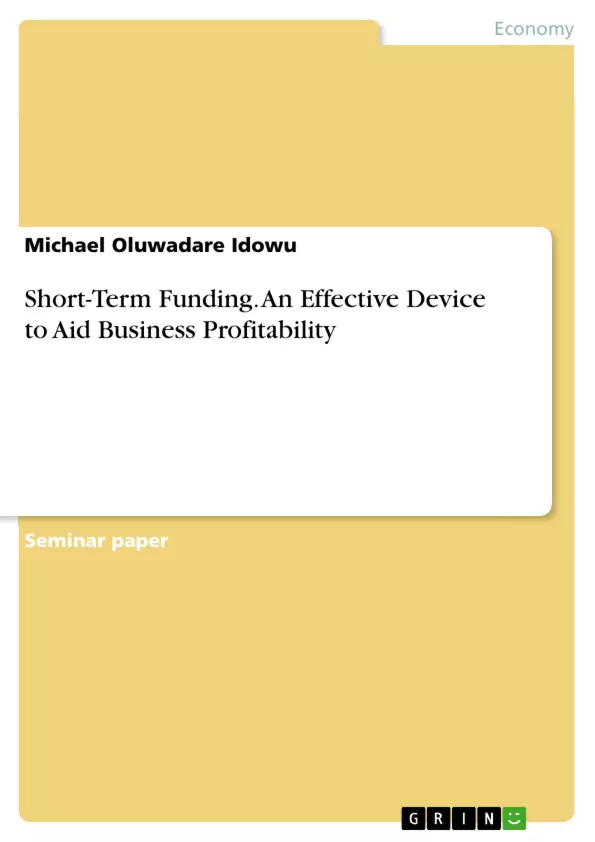The purpose of this write up is the discussion of how short-term funding can be used to aid business profitability. In order to achieve this objective, various sources of short term funding will be evaluated with a view to underscore the relative advantages and disadvantages. I will also recommend factors to consider before using short term funding.
The key purpose of any business venture is return. This can come in various forms such as profit maximization; maximization of contribution, shareholders wealth maximisation among others. These strategic objectives usually come in sizes depending on the nature of the business or organisation.
Lofty as strategic decisions may be, the importance of having adequate and efficient funding to support it cannot be over-emphasised. It has been shown again and again that one of the main reasons why business fails is the miss-matched of funding. Experience has shown that when you use your working capital (a form of short-term fund) to finance a capital project, the ability to run the business as a going –concern into a foreseeable future becomes shaky due to cash-flow problems.
Funding a business that requires a short-term funding with a long-term financing is a sure way to exist the market arena in an unceremoniously. It is therefore critical to have a right mix of fiancé to boost productivity and enhance competitive advantage.
Inhaltsverzeichnis (Table of Contents)
- INTRODUCTION
- DEFINITION OF KEY TERMS
- TYPE OF SHORT TERM FUNDING
- OWNER'S CAPITAL
- ESUSU
- BUSINESS OVERDRAFT
- LOANS FROM FAMILY, FRIENDS AND ASSOCIATES
- TRADE CREDITOR
- DEBT FACTORING AND INVOICE DISCOUNTING
- GUIDE TO USING SHORTERM FUNDING
- Make a clear vision and mission statement
- Evaluate the options
- Payback Period of the Investment
- Processing duration
- Inflation
- Interest Rate
- CONCLUSIONS
Zielsetzung und Themenschwerpunkte (Objectives and Key Themes)
The main objective of this paper is to discuss how short-term funding can be used to aid business profitability. The author will explore various sources of short-term funding, analyze their relative advantages and disadvantages, and offer recommendations for utilizing short-term funding effectively.
- The importance of short-term funding for business profitability
- The role of working capital in business success
- Different sources of short-term funding
- Factors to consider when using short-term funding
- The impact of short-term funding on cash flow management
Zusammenfassung der Kapitel (Chapter Summaries)
- Introduction: This chapter discusses the importance of funding in achieving business objectives, particularly the concept of short-term funding and its relevance to business profitability. It emphasizes the risks associated with mismatched funding and the need for a right mix of financing for optimal business performance.
- Definition of Key Terms: This chapter defines key terms related to finance and funding, such as short-term, long-term, profit, cash, financing, risk, and return.
- Type of Short Term Funding: This chapter presents an overview of different sources of short-term funding, including owner's capital, esusu, business overdraft, loans from family and friends, trade credit, and debt factoring/invoice discounting. It delves into the advantages and disadvantages of each source.
- Guide to Using Short-term Funding: This chapter focuses on the key factors to consider when using short-term funding, such as establishing a clear vision and mission, evaluating the options available, considering the payback period, processing duration, inflation, and interest rates.
Schlüsselwörter (Keywords)
Short-term funding, business profitability, working capital, cash flow management, owner's capital, esusu, business overdraft, loans, trade credit, debt factoring, invoice discounting, vision, mission, payback period, processing duration, inflation, interest rates.
- Citar trabajo
- Michael Oluwadare Idowu (Autor), 2013, Short-Term Funding. An Effective Device to Aid Business Profitability, Múnich, GRIN Verlag, https://www.grin.com/document/301384



